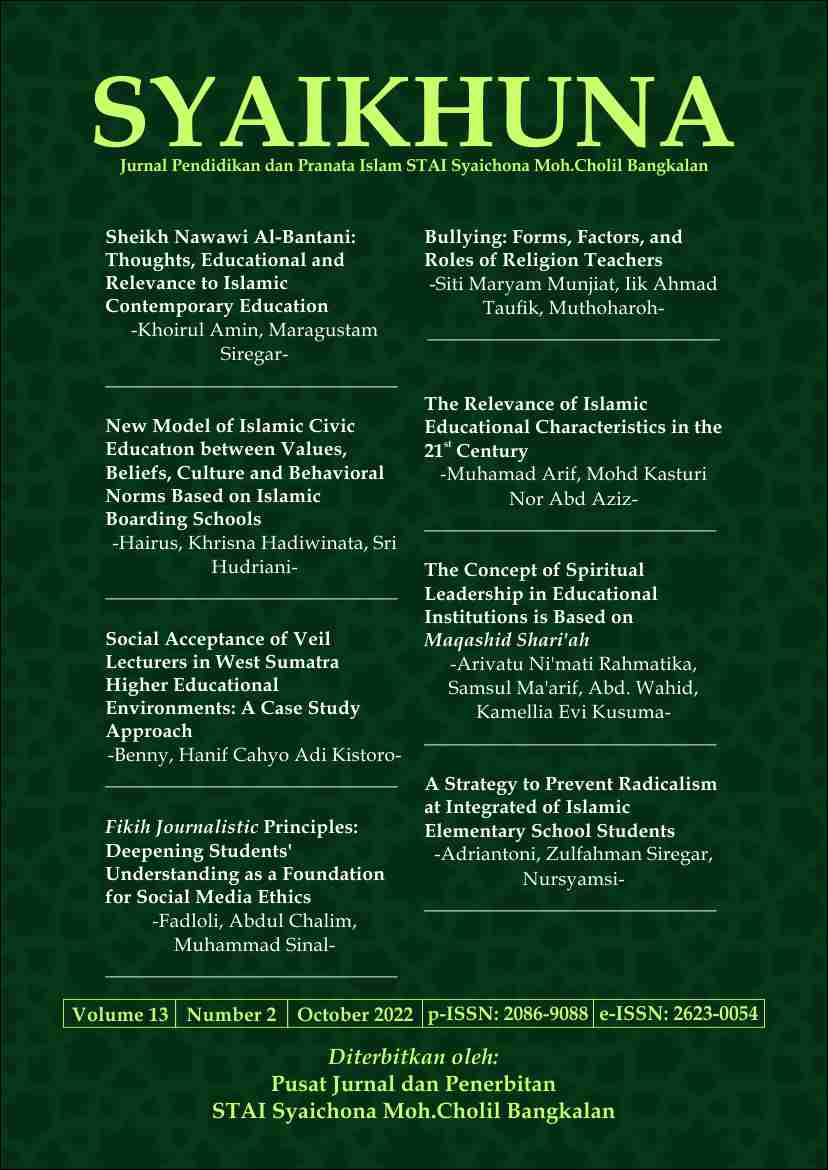Social Acceptance of Veil Lecturers in West Sumatra Higher Educational Environments: a Case Study Approach
DOI:
https://doi.org/10.36835/syaikhuna.v13i02.5976Keywords:
Social Acceptance, Veiled Lecturer, Public space, restrictionsAbstract
The strength of the negative stigma to women not only makes them ostracized but more of it in some room public women are veiled until they experience rejection, one of them in college high. Different from college another height, in one college high in West Sumatra, women veiled instead of accepted. On this campus, a lecturer has veiled for years. This research generally focuses on social reception. This research explains the acceptance of the lecturer veil at college height and what is just the driving factor a lecturer veiled can be accepted at college tall. Study this use approach study qualitative with research strategy studies case single type explanatory. Use method semi-structured interview with 11 informants from circle leaders, colleagues fellow lecturers, staff education and students. This study found that veiled lecturers at the college were in the accepted category. This means that socially veiled lecturers are not isolated. Though by appearance different from the lecturer in general lecturer veiled not differentiate themself from the environment. Likewise, party campuses do not treat lecturers veiled differently from lecturers others. The reception lecturer veiled this is also encouraged with the method religious lecturer a veil that is not disturbing others as well his personality is intelligent, obedient, disciplined, generous, and considerate.References
Andiko, T. (2018). Prohibition Veil in College Perspective _ Sadd al -Dzarîah. Madania: Journal of Islamic Studies, 22 (1), 113–130.
Barida, Muya. (2017). The 5 th Urecol Proceeding, 18 February 2017. UAD Yogyakarta.
Berk, Laura E. (2009). Child Development (6th ed.). Boston: Allyn & Bacon.
Berk, LE, & Meyers, AB (2008). Infants, Children, and Adolescents (6th ed.). Boston: Pearson Education. Retrieved from https://books.google.co.id / books?id = bwmxCgAAQBAJ
Cresswell, JW (2015). Research Design, Approach Qualitative, Quantitative, and Mixed (3rd ed.). Yogyakarta: Student Library.
Daud, FK (2018). Syar'i Hijab Trends and Polemics Veil: Observing squirm Islam Contemporary in Indonesia, (April), 39–53.
Grace, J. (2005). Psychology Communication Edition Revision. Bandung: PT. Teenager Rosdakarya.
Hasanah, Uswatun. (2017). Pilgrims Tabligh I (History and Development). El -Afkar: Journal of Thought Islam and Hadith Interpretation, 6(1), 1-10.
Hurlock, EB (1978). Child Development. (A. Dharma, Ed.) (6th ed.). Jakarta: Publisher Erlangga.
Kistoro, HCA, & Sibarani, ANL (2019). Relevance Map Value Concept Proverb Sunan Mountain Jati in Islamic Education. Journal of Islamic Religious Education Al- Thariqah, 4 (2), 24-40.
Kistoro, HCA, Kartowagiran, B., Naim, N., Latifah, E., Putranta, H., & Minggele, D. (2020). Islamophobia in education: perceptions on the wear of veil/niqab in higher education. Indonesian Journal of Islam and Muslim Societies, 10 (2), 227-246.
Kistoro, HCA, Kartowagiran, B., Naim, N., Latifah, E., Putranta, H., & Minggele, D. (2020). Islamophobia in education: perceptions on the wear of veil/niqab in higher education. Indonesian Journal of Islam and Muslim Societies, 10 (2), 227-246.
Latipah, Eva., Kistoro, Hanif Cahyo Adi., Khairunnisa (2020), Imaniyah, Scientific Attitudes in Islamic Education Learning: Relationship and the Role of Self-Efficacy and Social Support: Edukasia: Jurnal Penelitian Pendidikan Islam, 15(1), 37-56, 10.21043/edukasia.15i1.7364.
Mappiare, A. (1982). Psychology Teenagers. Surabaya: National Effort.
Noorbani, MA (2014). Development Stream / Get it Religion in West Sumatra. Multicultural and Multireligious Journal, 13 (1), 173-186.
Rahman, Abdul A. (2013). Psychology Social: Integration of Knowledge Revelation and Knowledge Empirical. Jakarta: Rajawali Press.
Ratri, L. (2011). The veil, the media, and the identity of Muslim women. Forum Journal, 39 (2), 29–37.
Sajari, D. (2015). MUI Fatwa About Genre Misguided in Indonesia (1976-2010). MIQOT: Journal of the Sciences Islam, 39 (1), 44-62.
Smith-Hefner, NJ (2007). Javanese Wand The Veil in Post- Soeharto Indonesia. Journal of Asian Studies, 66 (2), 389–420. https://doi.org/ 10.1017/ S0021911807000575
Stake, R.E. _ (2009). Studies Case in Handbook of Quality Research. Ed. Norman K Denzin, and Yvonna S Lincoln. Trans. Dariyatno, et al, Yogyakarta: Student Library.
Sunesti, Y. (2012). Public Space and Expression the Diversity of Hijabi Women in Yogyakarta. Sociology Reflective, 6 (2), 1–11. Retrieved from http://ejournal.uin-suka.ac.id/isoshum/sosiologireflektif/index
Taylor, SE (1995). Health Psychology. New York: Mc. Graw Hill Inc.
Van Bruinessen, Martin. (1992). The splinter movement among Indonesian Muslims: Background Behind Socio-Cultural. Ulumul Journal Qur'an, 3 (1), 6-27.
Witrianto. (2018). Development Pilgrims Tablighi in Padang City. Andalas University. Retrieved from http://repo.unand.ac.id/14829/
Yin, RK (2009). Case Study Research: Design and Method (ed.4). Thousand Oaks, CA: Sage
Downloads
Published
How to Cite
Issue
Section
License
Copyright (c) 2022 Beny Beny, Hanif Cahyo Adi Kistoro

This work is licensed under a Creative Commons Attribution 4.0 International License.





